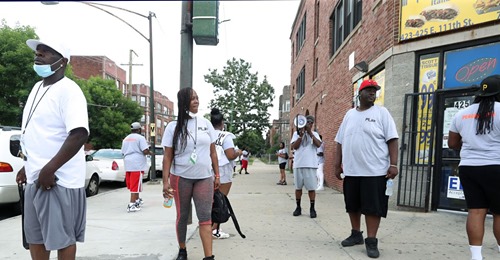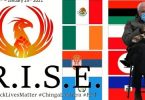
The days of supergangs framed by rigid hierarchies and sweeping turf wars are long gone. That’s been well-documented. So has the fragmentation of gangs into block-by-block cliques, driven more into violence by a perceived slight or a glowering stare — even from one of their own — than by a gang leader’s demand.
The new rules of engagement on the streets of Chicago’s South and West sides? Seems like there are none. Shoot your intended target, no matter how many innocent children, parents or senior citizens are in your way. Fire into a passing car or at people in a park? Fair game. It didn’t used to be that way.

So many times, too many times, Chicago has seen the fallout from violent outbursts that have grown more reckless. Natalia Wallace, 7, stood on a sidewalk in the West Side’s South Austin neighborhood July 4 when a car pulled up. The people inside got out and began firing. Police say Natalia was not the target, that the shooting was gang-on-gang retaliation. But that doesn’t matter. Natalia, described as a “quiet and sweet little girl” who would type “I love you” to her first grade teacher after each e-learning session, is gone.
So is Vernado Jones Jr., 14, fatally shot in the back in the South Side’s Englewood neighborhood July 4, and Mekhi James, 3, shot and killed while in the back seat of a car on Father’s Day weekend, and Sincere Gaston, just 20 months old, who like Mekhi was shot and killed in the back seat of a car. Other children on the South and West sides who have been shot in recent weeks have survived, bearing scars both physical and psychological that likely will last a lifetime.
How does this city convince a young man with a gun to not fire into cars with toddlers inside, or to not fire into a crowd and strike in the head a 7-year-old girl brimming with love and promise? Police strategies so far are failing. Mayor Lori Lightfoot’s efforts to control violence have been inadequate. Gov. J.B. Pritzker as a candidate promised to address crime through a special agency, but creating more bureaucracy, again, has not reversed alarming trends on the streets of Chicago.

The new ‘Interrupters’
00:1503:01

Last week, members of the Tribune Editorial Board spoke with a group of men who’ve had success in reaching young men engaged in gangs and gun violence. They’ve had success because they’ve been there. They’ve experienced the destitution that permeates the South and West sides, they know gang culture because they once belonged to it, and at various times in their lives, they’ve meted out violence too.
They connect with young people at risk because they understand the why and how of violent behavior, and can offer a way out — a job that leads to career, mentoring and counseling, a reservoir of trust these young men couldn’t find anywhere else. The organizations they belong to — Chicago CRED, READI Chicago, Metropolitan Peace Initiatives — strive for violence prevention through street outreach.
Takeaways from our conversation:
· While interpersonal conflict drives much of the gang violence on city streets today, “social media has been the accelerant for everything,” Jalon Arthur, director of strategic initiatives at CRED, tells us. A show of disrespect from one gang member to another gets posted on Facebook, is instantly seen and spread, and triggers retaliation with a spray of bullets.
“It makes the person that’s being attacked (on social media) say, ‘I have to do something now, to show I’m not this person who this other person said I was to these thousands of people,‘ ” says Napoleon English, an outreach worker at READI Chicago.

· Arthur estimates that one-third of shooting victims in Chicago are unintended targets “caught in crossfire due to close proximity. … What we are doing about that now is the burning question for me.” When Arthur and other street outreach workers talk with young men with guns about new rules of engagement, the message is weighted with blunt practicality.
“GAP. Give A Pass,” he tells them, as in, pass up on firing into large gatherings, or at people in cars. “Stop lighting these cars up. A lot of time you have babies in these cars, other people in those cars.” No “half-court shots”— don’t fire from a block away. Schools, parks, community centers and churches are off limits.
Jarring that those uncomfortable yet practical lessons are part of a strategy to protect unintended targets in shootings? They should be jarring. This is where we’re at as a city.
· Street outreach works. In neighborhoods where outreach workers are deployed, violence is down. At READI Chicago, more than half of the young men who join the program remain engaged in it a year later, according to the University of Chicago Crime Lab. “When our guys are on duty — evenings and weekends — the shootings in those locations have dropped to almost zero,” wrote Arne Duncan, founder of CRED and education secretary under former President Barack Obama in a Tribune op-ed co-authored with READI executive director Eddie Bocanegra and Vaughn Bryant, who heads up Metropolitan Peace Initiatives.

‘Police can’t solve the problem alone’
And yet, street outreach remains under-resourced. Philanthropic groups provide much of the funding, though earlier this year Lightfoot pledged $6 million in city funds to street outreach efforts. More is needed. Arthur says the ranks of street outreach workers need to be doubled, or even quadrupled. At READI, it costs $20,000 annually to pay for each participant. But a year in an Illinois prison costs $38,000. “It’s not a cheap program,” Bocanegra tells us. “But when you compare it to prison? What we pay as taxpayers … for police, for the cost of detention? We’re not educating the public about that comparison.”
There’s no cure-all for the scourge of gun violence that has persisted for decades. Police can’t solve the problem alone. Neither can new laws or the next torrent of outrage. As Arthur says, “We need all hands on-deck.” A police department that commits to forging real and lasting trust in neighborhoods. Buy-in from the private sector to reverse yearslong disinvestment and seed job growth. A City Hall that focuses unrelentingly on crime reduction.
Part of the solution, however, is a commitment to street outreach. Efforts that work deserve expansion. Every at-risk young man who buys into the message from programs such as CRED, READI and Metropolitan Peace is one more life turned away from violence. Such turnarounds are far from impossible. “Violence is a learned behavior, and it can be unlearned,” Arthur says. “A lot of violent offenders have also been violently victimized. They’ve learned violence and they’ve learned to respond to conflicts in a certain way.”
By itself, street outreach won’t rid the South and West sides of violence. But it deserves to be a bigger part of the answer.
Editorials reflect the opinion of the Chicago Tribune Editorial Board.
Get our latest editorials, commentaries and columns delivered twice a week in our Fighting Words newsletter. Sign up here.
Join the discussion on Twitter @chitribopinions and on Facebook.
Submit a letter, of no more than 400 words, to the editor here or email letters@chicagotribune.com.






